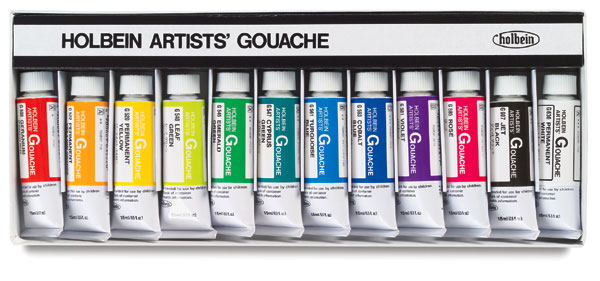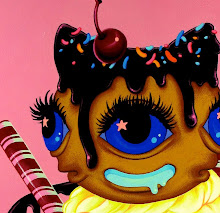There is one brand of everything that I'm obsessed with, and that brand is Holbein.
Hans Holbein was some famous artist guy whose name they decided to use to get artists to think that if they used Holbein materials, they could paint like him. Same with Rembrandt paints, along with Van Gogh and M. Graham. Working at an art store, I have a lot of knowledge stored up in my tiny brain of the different qualities, pigment intensities, and consistency of each of these types of paints.
But Holbein hit the nail on the head. A German brand produced in Japan, Holbein has never failed me. In my experiences with many types of paints and materials, they've consistently shown me super high quality in all of their products, from comic patterns to gouache.
Today, as a present for myself, I bought this.

I bought the tub on the left. 330ml of beautiful, rich, super opaque bright Titanium White acrylic paint. I've found many of their acrylic paints to have a transparent quality to them (which isn't for me), and for the amount of a paint most acrylic artists use, I probably wouldn't recommend them. But the fact that you can mix them with their gouache and water-soluble oil paints is excellent. I recently just invested in a set of the water-soluble oils, but working on a primed surface is still a new thing for me (I work on super heavyweight hot press board normally), so I've yet to partake in their glory.
So for now, I'm using what I consider to be the holy grail of paints, Holbein Acryla Gouache.

Gouache based with acrylic polymer and Titanium white, I have never used more vibrant paint. If you were to apply this paint as a wash onto a black surface, it would dry super-matte with no streaks. That, to me, is BEAUTIFUL. As a graphic artist who likes to use traditional materials, I haven't found a comparison as of yet. And I only started using them as a fluke - I hated gouache, but I loved their color selection. Who knew I would fall in love with them?
They also carry a professional grade gouache that is SUPER PIGMENT RICH. While most classes suggest Winsor Newton gouache, I see no comparison. I will almost always recommend these instead to students. Why get the generic brand when you can get BETTER? For LESS MONEY? And it's all about money these days.
 So to conclude my Holbein review, there is one product I cannot fail to recommend to any traditional comic artist: Holbein comic patterns. While digital screentones are easy to find and easy to use, there's something about being able to hold a finished piece in your hands with traditional media.
So to conclude my Holbein review, there is one product I cannot fail to recommend to any traditional comic artist: Holbein comic patterns. While digital screentones are easy to find and easy to use, there's something about being able to hold a finished piece in your hands with traditional media.There are two different varieties: there are contact paper screentones that you can buy in large sheets (about a 10" x 14") along with rub-on transfers. The contact paper ones are digitally printed images of gradients, patterns, scenery, architecture, and objects. They're used by cutting the pattern to fit a certain shape and burnishing on. I've used these before, and while I may not have been using fresh-off-the-press patterns, I wasn't impressed with how tiny the halftone dots were. If you were working very small, you might get a better affect, but for me, I like to SEE the pattern.
But the rub-on patterns are beyond decadent. Much like the outdated (yet incredible) Gocco printing process, these are on their way to being discontinued. You can't even find them online. They consist of a layer of digitally processed ink that is laid onto a piece of wax paper and can then be burnished onto paper. The dots are permanent, beautiful, and they don't gleam with cheesiness the way the contact paper transfers do. For a 6" x 8" sheet, you can still find them in some art stores for around $8 a sheet.
HOWEVER, if you'd like to try your hand at these before they're gone, at Blick Art Materials (in Boston), in the back of the store on the clearance table is a full display of these babies - 25 different varieties, available for $4.67 per sheet (not including your student/faculty discount of an extra 10%). They were forgotten by Blick after they were discontinued for the store about a year ago, and the price has continued to drop since then. I've refused to move them, hoarding them for myself, so if you want to try them out, get them before I buy the rest out. They're AMAZING. I'll even gleefully show you where they are if I'm working. (No one else there even knows what they're for.)
To conclude, I'd like to post a piece or two I've completed solely with Holbein gouache and acrylic. I have yet to complete anything with the transfer sheets as I treasure them like gold.



But thanks for listening to my review. If there are any art materials you've been looking to try, or any sort of affect you've been trying to achieve but don't know where to look, ask me. I'm a walking catalog for everything that is art materials, and I'm always excited to answer questions. Thanks!
(Bonus fun fact: Holbein packages most of their paints in plastic tubes - I can't stand metal tubes or anything metal for that matter. I eat all of my meals with plastic cutlery and children's plasticware.)


2 comments:
Do you know what the big differences are between water based oils and regular oils, like when it comes to consistency and rate at which they dry? I haven't tried the water based ones but I've been very interested in them since I have been dying to paint in oils but haven't been able to figure out the right ventilation for them.
When I first tried oils last semester in my living room with one window open I thought "bah I've never been worried about ventilation before, its probably not a big deal for every single time" And then two minutes into it the fumes made me feel what I imagine its like to huff glue, and then gasoline, and then more glue..
Your blog keeps getting better and better! Your older articles are not as good as newer ones you have a lot more creativity and originality now keep it up!
Post a Comment